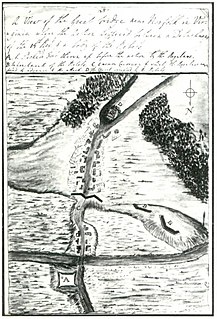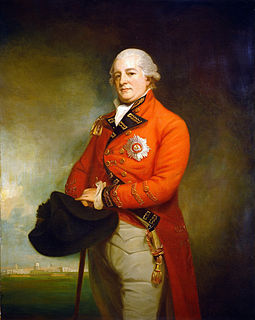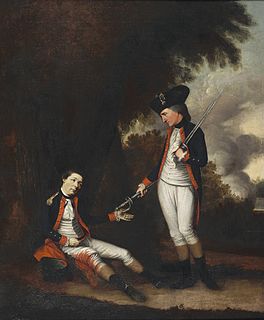 W
WThe Battle of Beaufort, also known as the Battle of Port Royal Island, was fought on February 3, 1779, near Beaufort, South Carolina, during the American Revolutionary War. The battle took place not long after British forces consolidated control around Savannah, Georgia, which they had captured in December 1778.
 W
WThe Battle of Brier Creek was an American Revolutionary War battle fought on March 3, 1779 near the confluence of Brier Creek with the Savannah River in eastern Georgia. A Patriot force consisting principally of militia from North Carolina and Georgia was defeated, suffering significant casualties. The battle occurred only a few weeks after a Patriot victory over a Loyalist militia at Kettle Creek, north of Augusta, reversing its effect on morale.
 W
WThe Battle of Great Bridge was fought December 9, 1775, in the area of Great Bridge, Virginia, early in the American Revolutionary War. The victory by colonial Virginia militia forces led to the departure of Royal Governor Lord Dunmore and any remaining vestiges of British power over the Colony of Virginia during the early days of the conflict.
 W
WThe Battle of Great Cane Brake was a skirmish fought on December 22, 1775, during the American Revolutionary War in what was then Ninety-Six District, South Carolina, modern Greenville County.
 W
WThe Battle of Kemp's Landing, also known as the Skirmish of Kempsville, was a skirmish in the American Revolutionary War that occurred on November 15, 1775. Militia companies from Princess Anne County in the Province of Virginia assembled at Kemp's Landing to counter British troops under the command of Virginia's last colonial governor, John Murray, Lord Dunmore, that had landed at nearby Great Bridge. Dunmore was investigating rumors of Patriot troop arrivals from North Carolina that turned out to be false; he instead moved against the Princess Anne militia, defeating their attempt at an ambush and routing them.
 W
WThe Battle of Kettle Creek was the first major victory for Patriots in the back country of Georgia during the American Revolutionary War that took place on February 14, 1779. It was fought in Wilkes County about eight miles (13 km) from present-day Washington, Georgia. A militia force of Patriots decisively defeated and scattered a Loyalist militia force that was on its way to British-controlled Augusta.
 W
WThe Battle of Moore's Creek Bridge was a minor conflict of the American Revolutionary War fought near Wilmington, North Carolina, on February 27, 1776. The victory of the North Carolina Provincial Congress' militia force over British governor Josiah Martin's reinforcements at Moore's Creek marked the decisive turning point of the Revolution in North Carolina. American independence would be declared less than five months later.
 W
WThe Burning of Norfolk was an incident that occurred on January 1, 1776, during the American Revolutionary War. British Royal Navy ships in the harbor of Norfolk, Virginia began shelling the town, and landing parties came ashore to burn specific properties. The town, whose significantly Tory (Loyalist) population had fled, was occupied by Whig (Revolutionary) forces from Virginia and North Carolina. Although these forces worked to drive off the landing parties, they did nothing to impede the progress of the flames, and began burning and looting Tory properties.
 W
WThe Battle of the Rice Boats, also called the Battle of Yamacraw Bluff, was a land and naval battle of the American Revolutionary War that took place in and around the Savannah River on the border between the Province of Georgia and the Province of South Carolina on March 2 and 3, 1776. The battle pitted the Patriot militia from Georgia and South Carolina against a small fleet of the Royal Navy.
 W
WThe siege of Savage's Old Fields was an encounter between Patriot and Loyalist forces in the back country town of Ninety Six, South Carolina, early in the American Revolutionary War. It was the first major conflict in South Carolina in the war, having been preceded by bloodless seizures of several military fortifications in the province. Patriot forces under the command of Major Andrew Williamson had been dispatched to the area to recover a shipment of gunpowder and ammunition intended for the Cherokees that had been seized by Loyalists. Williamson's force, numbering over 500, established a stockaded fort near Ninety Six, where it was surrounded by some 1,900 Loyalists.
 W
WThe siege of Savannah or the Second Battle of Savannah was an encounter of the American Revolutionary War (1775–1783) in 1779. The year before, the city of Savannah, Georgia, had been captured by a British expeditionary corps under Lieutenant-Colonel Archibald Campbell. The siege itself consisted of a joint Franco-American attempt to retake Savannah, from September 16 to October 18, 1779. On October 9 a major assault against the British siege works failed. During the attack, Polish nobleman Count Casimir Pulaski, leading the combined cavalry forces on the American side, was mortally wounded. With the failure of the joint attack, the siege was abandoned, and the British remained in control of Savannah until July 1782, near the end of the war.
 W
WThe Capture of Savannah, or sometimes the First Battle of Savannah, or the Battle of Brewton Hill, was an American Revolutionary War battle fought on December 29, 1778 pitting local American Patriot militia and Continental Army units, holding the City, against a British invasion force under the command of Lieutenant Colonel Archibald Campbell. The British capture of the city led to an extended occupation and was the opening move in the British southern strategy to regain control of the rebellious Southern provinces by appealing to the relatively strong Loyalist sentiment there.
 W
WThe Snow Campaign was one of the first major military operations of the American Revolutionary War in the southern colonies. An army of up to 3,000 Patriot militia under Colonel Richard Richardson marched against Loyalist recruiting centers in South Carolina, flushing them out and frustrating attempts by the Loyalists to organize. The Patriot expedition became known as the Snow Campaign due to heavy snowfall in the later stages of the campaign.
 W
WThe Battle of Stono Ferry was an American Revolutionary War battle, fought on June 20, 1779, near Charleston, South Carolina. The rear guard from a British expedition retreating from an aborted attempt to take Charleston held off an assault by poorly trained militia forces under American General Benjamin Lincoln.
 W
WThe Battle of Sullivan's Island or the battle of Fort Sullivan was fought on June 28, 1776, during the American Revolutionary War. It took place near Charleston, South Carolina, during the first British attempt to capture the city from American forces. It is also sometimes referred to as the first siege of Charleston, owing to a more successful British siege in 1780.